The Case for a Single Channel Composite Arctic Sea Surface Temperature Algorithm
Abstract
1. Introduction
2. Materials and Methods
2.1. CASSTA
2.1.1. Split Window Algorithms
2.1.2. Arctic SST
2.1.3. IST
2.1.4. Marginal Ice Zone Surface Temperature
2.2. CASSTA Revisited
2.2.1. IST Reanalysis
- Although it was recognized that BTD11–12 should also affect the IST, the limited number and range of datapoints in the ice regime did not produce a meaningful linear regression. Standard regression analyses for the 50 marginal ice zone points, or a combination of ice and marginal ice zone, were also not successful [18].
- An established IST split window algorithm for NOAA-12 was available [20] and gave unexpected accuracy for the designated ice pixels. Incorporation of the IST algorithm into the MIZST produced good results.
2.2.2. New Ice Data
3. Results
4. Discussion
4.1. Single Channel IST
4.2. Single Channel CASSTA Considerations
5. Conclusions
Author Contributions
Funding
Conflicts of Interest
References
- Maykut, G.A. Energy Exchange Over Young Sea Ice in the Central Arctic. J. Geophys. Res. 1978, 83, 3646–3658. [Google Scholar] [CrossRef]
- Hall, D.K.; Key, J.R.; Casey, K.A.; Riggs, G.A.; Cavalieri, D.J. Sea ice surface temperature product from MODIS. IEEE Trans. Geosci. Remote Sens. 2004, 42, 1076–1087. [Google Scholar] [CrossRef]
- Chapman, W.L.; Walsh, J.E. Simulations of arctic temperature and pressure by global coupled models. J. Clim. 2007, 20, 609–632. [Google Scholar] [CrossRef]
- Dybkjær, G.R.; Tonboe, R.; Høyer, J.L. Arctic surface temperatures from Metop AVHRR compared to in situ ocean and land data. Ocean Sci. 2012, 8, 959–970. [Google Scholar] [CrossRef]
- Marcq, S.; Weiss, J. Influence of sea ice lead-width distribution on turbulent heat transfer between the ocean and the atmosphere. Cryosphere 2012, 6, 143–156. [Google Scholar] [CrossRef]
- Liu, Y.; Dworak, R.; Key, J. Ice Surface Temperature Retrieval from a Single Satellite Imager Band. Remote Sens. 2018, 10, 1909. [Google Scholar] [CrossRef]
- Serreze, M.; Francis, J. The Arctic Amplification Debate. Clim. Chang. 2006, 76, 241–264. [Google Scholar] [CrossRef]
- Solomon, S.; Qin, D.; Manning, M.; Marquis, M.; Averyt, K.; Tignor, M.M.B.; Miller, H.L.; Chen, Z. (Eds.) Climate Change 2007: The Physical Science Basis; Cambridge Univ. Press: Cambridge, UK, 2008. [Google Scholar]
- Kearns, E.J.; Hanafin, J.A.; Evans, R.H.; Minnett, P.J.; Brown, O.B. An independent assessment of Pathfinder AVHRR sea surface temperature accuracy using the Marine Atmosphere Emitted Radiance Interferometer (M-AERI). Bull. Am. Meteorol. Soc. 2000, 81, 1525–1536. [Google Scholar] [CrossRef]
- McClain, E.; Pichel, W.; Walton, C. Comparative performance of AVHRR-based multichannel sea surface temperatures. J. Geophys. Res. 1985, 90, 11587–11601. [Google Scholar] [CrossRef]
- Key, J.; Maslanik, J.A.; Papakyriakou, T.; Serreze, M.C.; Schweiger, A.J. On the validation of satellite-derived sea ice surface temperature. Arctic 1994, 47, 280–287. [Google Scholar] [CrossRef]
- Scambos, T.A.; Haran, T.M.; Massom, R. Validation of avhrr and modis ice surface temperature products using in situ radiometers. Ann. Glaciol. 2006, 44, 345–351. [Google Scholar] [CrossRef]
- Shuman, C.A.; Hall, D.K.; DiGirolamo, N.E.; Mefford, T.K.; Schnaubelt, M.J. Comparison of near-surface air temperatures and modis ice-surface temperatures at summit, greenland (2008–13). J. Appl. Meteorol. Climatol. 2014, 53, 2171–2180. [Google Scholar] [CrossRef]
- Kilpatrick, K.A.; Podestá, G.P.; Evans, R. Overview of the NOAA/NASA advanced very high resolution radiometer Pathfinder algorithm for sea surface temperature and associated matchup database. J. Geophys. Res. 2001, 106, 9179–9197. [Google Scholar] [CrossRef]
- Minnett, P. A numerical study of the effects of anomalous North Atlantic atmospheric conditions on the infrared measurement of sea surface temperature from space. J. Geophys. Res. 1986, 91, 8509–8521. [Google Scholar] [CrossRef]
- Emery, W.; Yu, Y.; Wick, G.; Schluessel, P.; Reynolds, R. Correcting infrared satellite estimates of sea surface temperature for atmospheric water vapor attenuation. J. Geophys. Res. 1994, 99, 5219–5236. [Google Scholar] [CrossRef]
- Kumar, A.; Minnett, P.; Podestá, G.; Evans, R. Error Characteristics of the Atmospheric Correction Algorithms Used in Retrieval of Sea Surface Temperatures from Infrared Satellite Measurements: Global and Regional Aspects. J. Atmos. Sci. 2003, 60, 575–585. [Google Scholar] [CrossRef]
- Vincent, R.F.; Marsden, R.F.; Minnett, P.J.; Creber, K.A.M.; Buckley, J.R. Arctic waters and marginal ice zones: A composite Arctic sea surface temperature algorithm using satellite thermal data. J. Geophys. Res. 2008, 113, C04021. [Google Scholar] [CrossRef]
- Vincent, R.F.; Marsden, R.F.; Minnett, P.J.; Buckley, J.R. Arctic waters and marginal ice zones: 2. An investigation of arctic atmospheric infrared absorption for advanced very high resolution radiometer sea surface temperature estimates. J. Geophys. Res. 2008, 113, C08044. [Google Scholar] [CrossRef]
- Key, J.; Collins, J.B.; Fowler, C.; Stone, R.S. High-Latitude Surface Temperature Estimates from Thermal Satellite Data. Remote. Sens. Environ. 1997, 61, 302–309. [Google Scholar] [CrossRef]
- Minnett, P.J.; Knuteson, R.O.; Best, F.A.; Osborne, B.J.; Hanafin, J.A.; Brown, O.B. The Marine-Atmosphere Emitted Radiance Interferometer (M-AERI), a high-accuracy, sea-going infrared spectroradiometer. J. Atmos. Ocean. Technol. 2001, 18, 994–1013. [Google Scholar] [CrossRef]
- Huang, H.-L.; Yang, P.; Wei, H.; Baum, B.A.; Hu, Y.; Antonelli, P.; Ackerman, S.A. Inference of ice cloud properties from high spectral resolution infrared observations. IEEE Trans. Geosci. Remote Sens. 2004, 42, 842–853. [Google Scholar] [CrossRef]
- Arnott, W.P.; Dong, Y.Y.; Hallett, J. Extinction efficiency in the infrared (2–18 mm) of laboratory ice clouds: Observations of scattering minima in the Christiansen bands of ice. Appl. Opt. 1995, 34, 541–551. [Google Scholar] [CrossRef] [PubMed]
- Hori, M.; Aoki, T.; Tanikawa, T.; Motoyoshi, H.; Hachikubo, A.; Sugiura, K.; Yasunari, T.J.; Eide, H.; Storvold, R.; Nakajima, Y. In situ measured spectral directional emissivity of snow and ice in the 8–14 μm atmospheric window. Remote Sens. Environ. 2006, 100, 486–502. [Google Scholar] [CrossRef]
- Hori, M.; Aoki, T.; Tanikawa, T.; Hachikubo, A.; Sugiura, K.; Kuchiki, K.; Niwano, M. Modeling angular-dependent spectral emissivity of snow and ice in the thermal infrared atmospheric window. Appl. Opt. 2013, 52, 7243–7255. [Google Scholar] [CrossRef]
- Dybkjær, G.; Høyer, J.; Tonboe, R.; Olsen, S.; Rodwell, S.; Wimmer, W.; Søbjærg, S. QASITEEX 2011—The Qaanaaq Sea Ice Thermal Emission Experiment Field Report; Technical Report, tr11-18; Danish Meteorological Institute: Copenhagen, Denmark, 2011; Available online: http://www.dmi.dk/dmi/tr11-18.pdf (accessed on 13 September 2019).
- Donlon, C.; Robinson, I.S.; Wimmer, W.; Fisher, G.; Reynolds, M.R.; Edwards, R.T.J.; Nightingale, T.S. An infrared sea surface temperature autonomous radiometer (isar) for Deployment aboard volunteer observing ships (vos). J. Atmos. Ocean. Technol. 2008, 25, 93–113. [Google Scholar] [CrossRef]
- Li, Y.; Liu, T.; Shokr, M.; Wang, Z.; Zhang, L. An Improved Single-Channel Polar Region Ice Surface Temperature Retrieval Algorithm Using Landsat-8 Data. IEEE Trans. Geosci. Remote Sens. 2019, 1–13. [Google Scholar] [CrossRef]
- Herman, G.; Goody, R. Formation and persistence of summertime Arctic stratus clouds. J. Atmos. Sci. 1976, 33, 1537–1553. [Google Scholar] [CrossRef]
- Vowinckel, E.; Orvig, S. The climate of the north polar basin. In World Survey of Climatology; Orvig, S., Ed.; Elsevier: Amsterdam, The Netherlands, 1970; Volume 14, pp. 129–252. [Google Scholar]
- Vincent, R.F. The Effect of Arctic Dust on the Retrieval of Satellite Derived Sea and Ice Surface Temperatures. Sci. Rep. 2018, 8, 9727. [Google Scholar] [CrossRef]
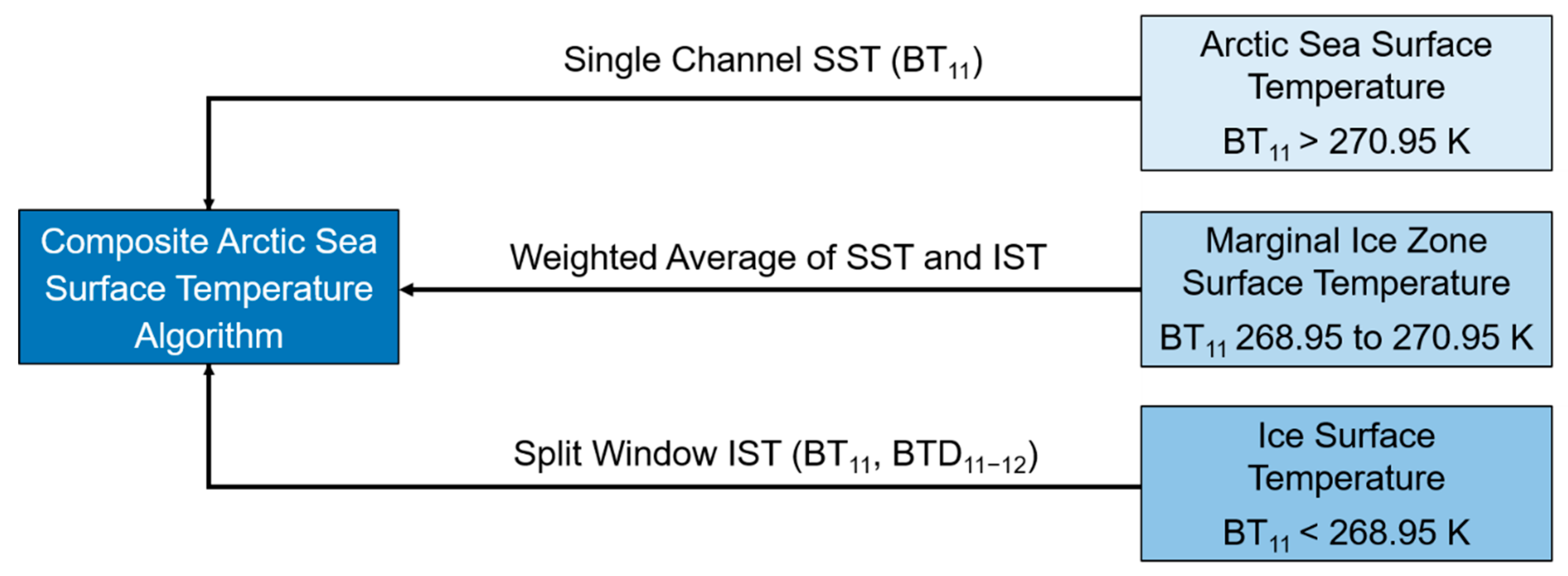
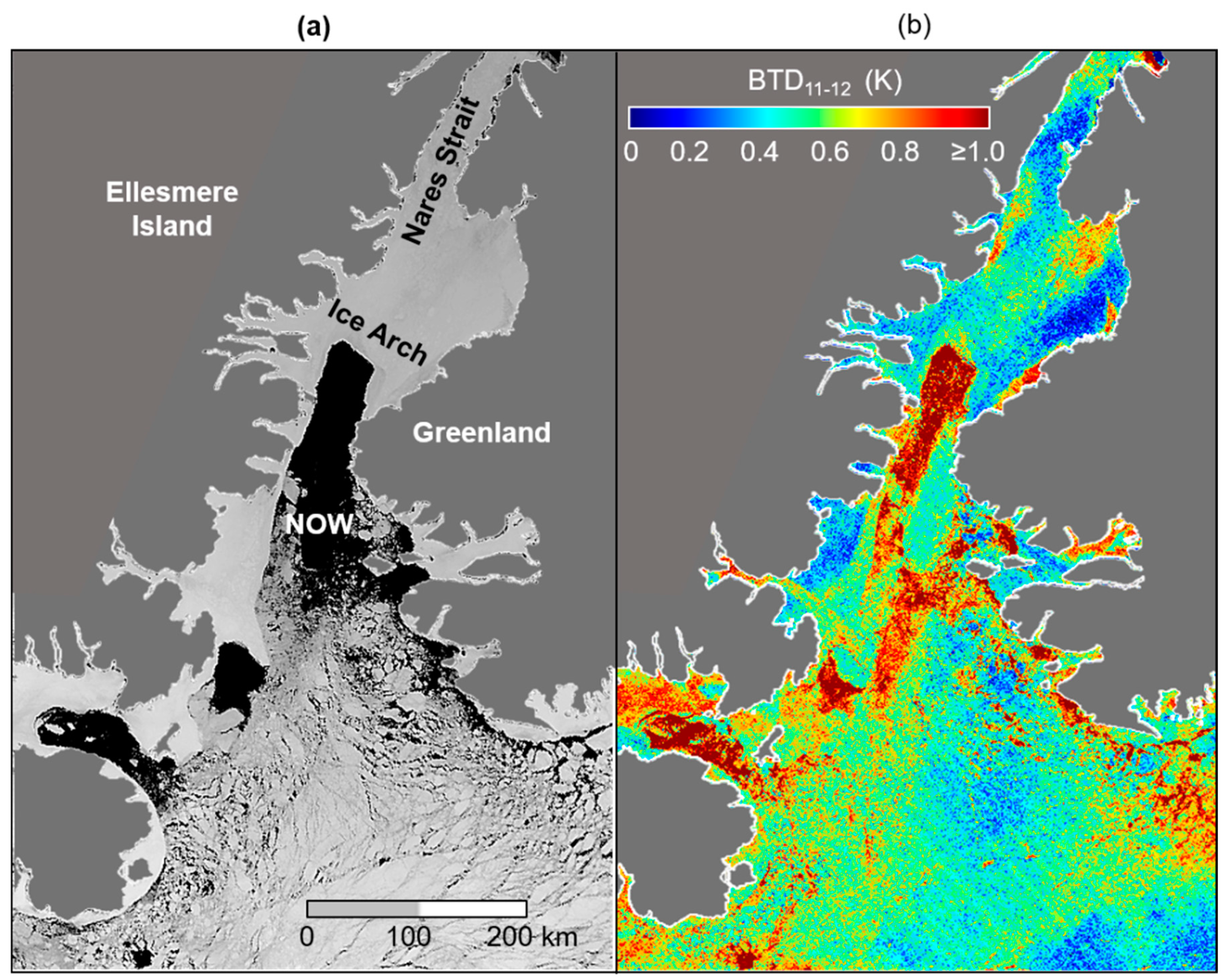
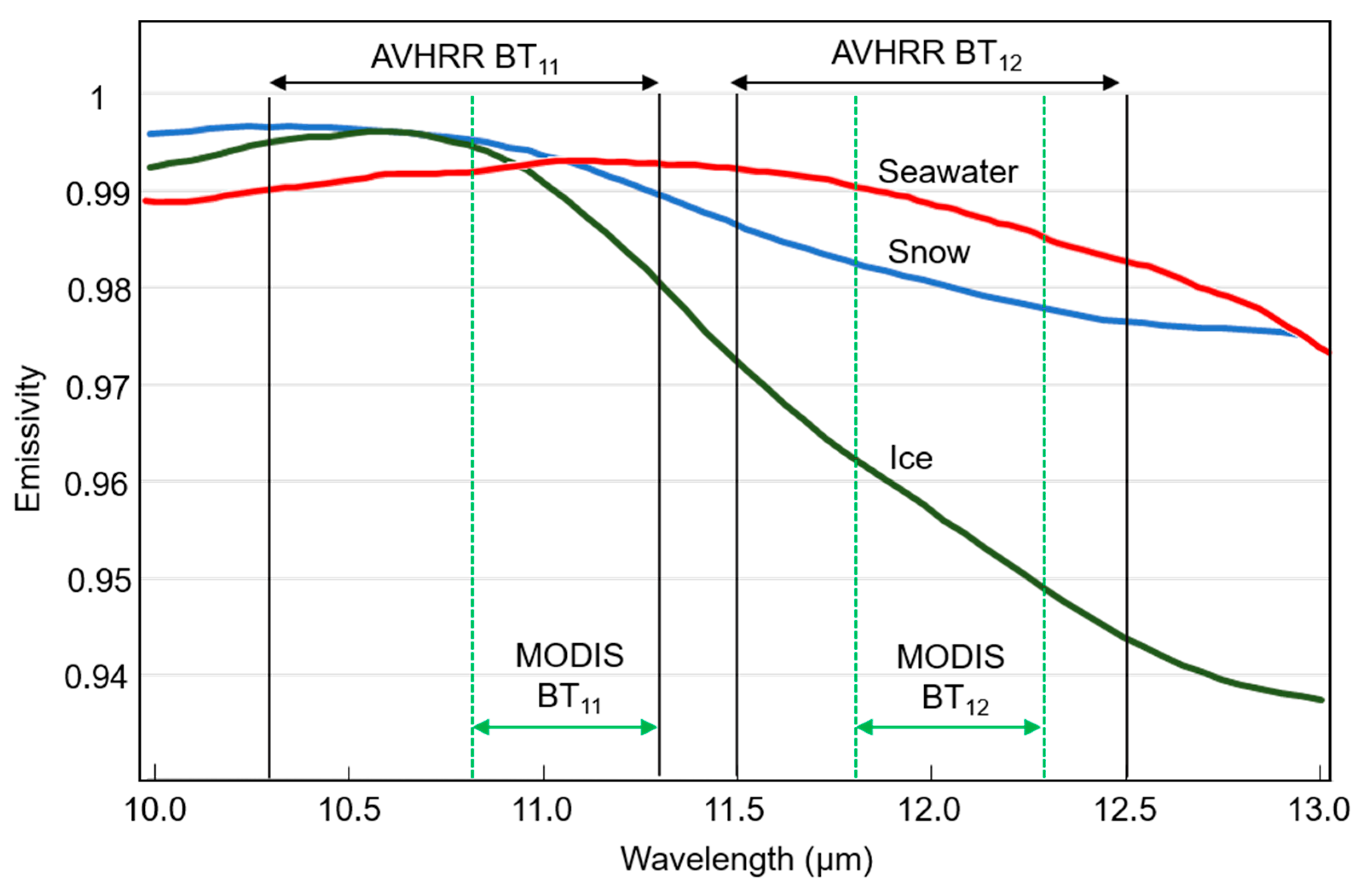
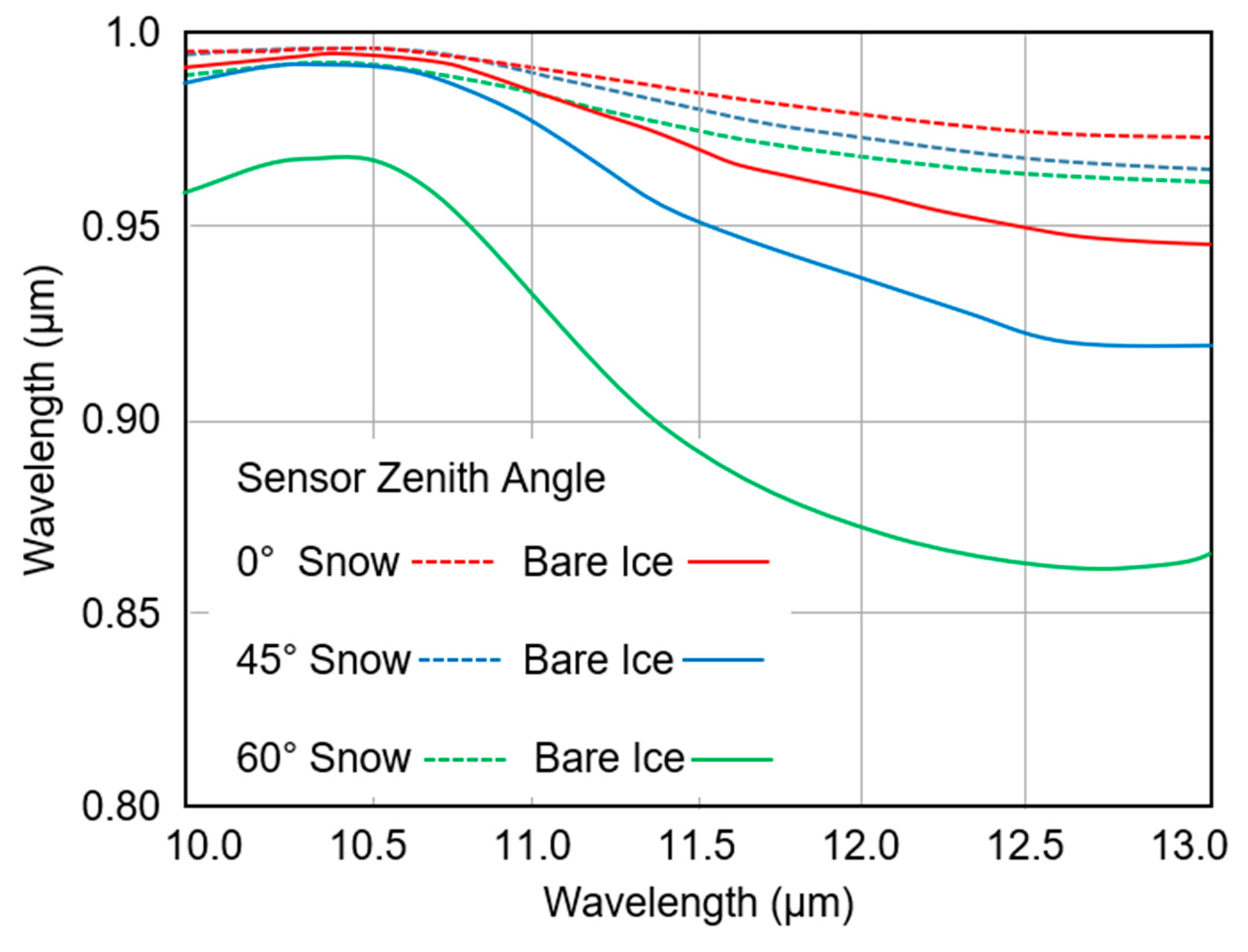
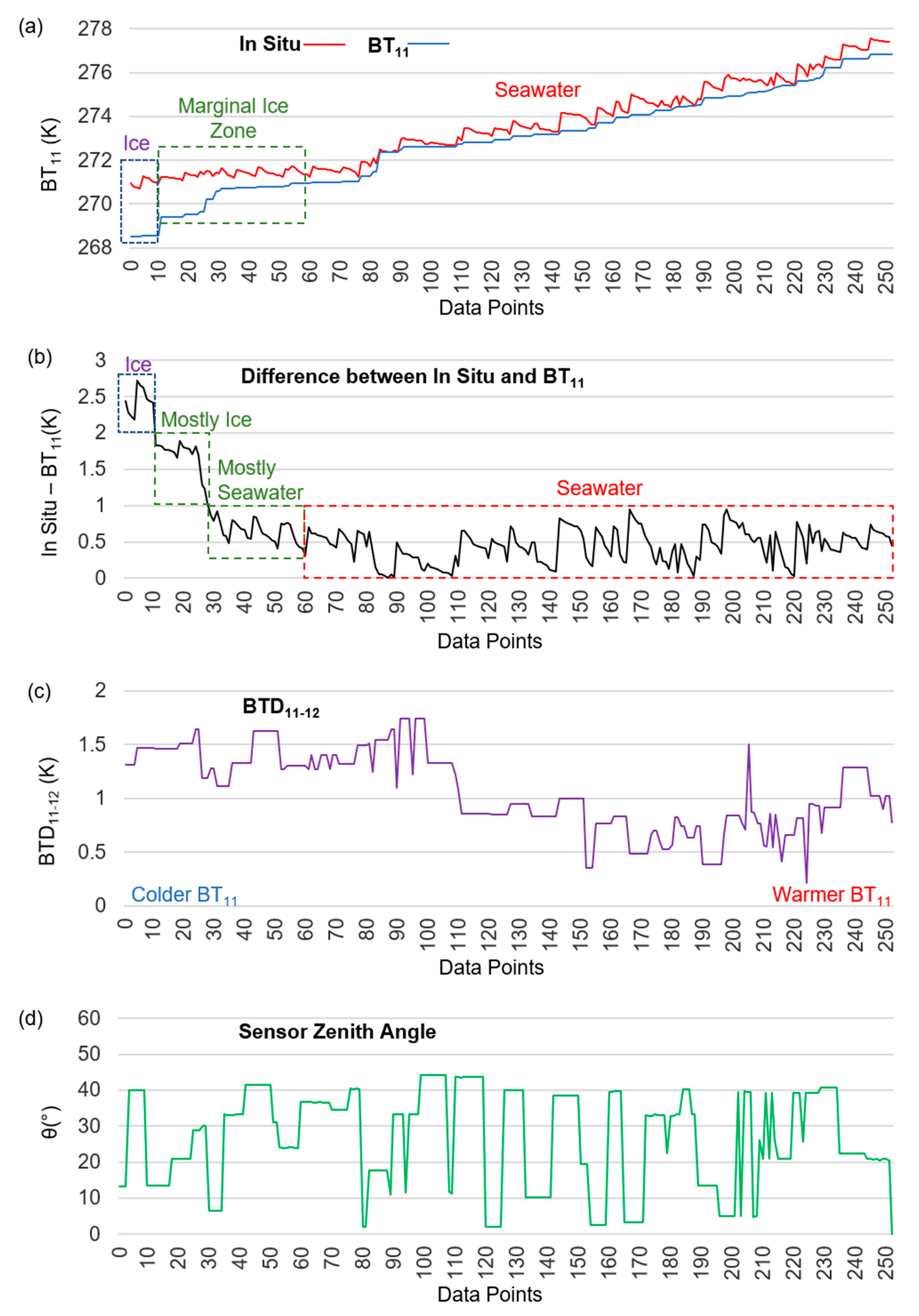
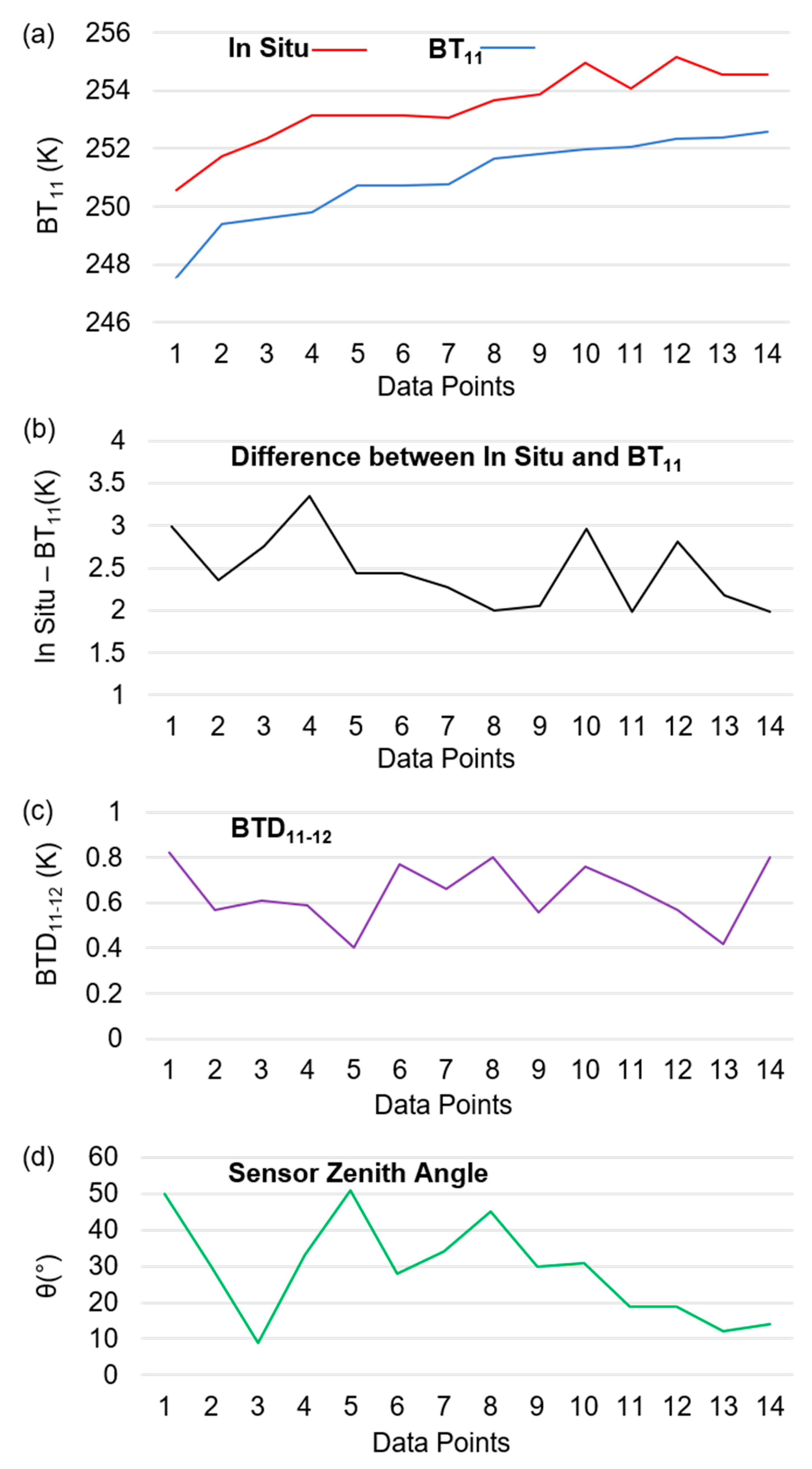
| Sensor | Satellite | Total Channels | TIR Channels | TIR Nadir Resolution | Sensor Topology |
|---|---|---|---|---|---|
| AVHRR | TIROS-N, NOAA-6 to NOAA-19 MetOp-A,-B,-C | 6 | Channel 4 10.3 μm–11.3 μm Channel 5 11.5 μm–12.5 μm | 1.1 km | Scanning ±55° 2900 km swath |
| MODIS | Terra Aqua | 36 | Channel 31 10.8 μm–11.3 μm Channel 32 11.8 μm–12.3 μm | 1 km | Scanning ±55° 2330 km swath |
| VIIRS | S-NPP NOAA-20 | 22 | Channel M15 10.26 μm–11.26 μm Channel M16 11.54 μm–12.49 μm | 750 m | Scanning ±56° 3040 km swath |
| TIRS | Landsat-8 | 11 | Channel 10 10.60 μm–11.20 μm Channel 11 11.50 μm–12.51 μm | 100 m | Pushbroom 185 km Swath |
| Algorithm | Ice Regime | Marginal Ice Zone Regime |
|---|---|---|
| Split Window IST | Mean Average Error: 0.144 K Standard Deviation: 0.183 K Average Bias: +0.01 K | Mean Average Error: 0.136 K Standard Deviation: 0.165 Average Bias: −0.03 K |
| Single Channel IST | Mean Average Error: 0.142 K Standard Deviation: 0.182 Average Bias: −0.02 K | Mean Average Error: 0.128 K Standard Deviation: 0.155 K Average Bias: −0.03 K |
| Consideration | Comment |
|---|---|
| Cloud | Cloud free conditions required. |
| BTD11–12 > 2.0 °C | Indication of ice fog. Inaccurate surface temperature returned. |
| BTD11–12 < 0 °C | Indication of dust. Inaccurate surface temperature returned. |
| Sensor Zenith Angle | Sensor zenith angle <45° for best results. |
© 2019 by the author. Licensee MDPI, Basel, Switzerland. This article is an open access article distributed under the terms and conditions of the Creative Commons Attribution (CC BY) license (http://creativecommons.org/licenses/by/4.0/).
Share and Cite
Vincent, R.F. The Case for a Single Channel Composite Arctic Sea Surface Temperature Algorithm. Remote Sens. 2019, 11, 2393. https://doi.org/10.3390/rs11202393
Vincent RF. The Case for a Single Channel Composite Arctic Sea Surface Temperature Algorithm. Remote Sensing. 2019; 11(20):2393. https://doi.org/10.3390/rs11202393
Chicago/Turabian StyleVincent, R.F. 2019. "The Case for a Single Channel Composite Arctic Sea Surface Temperature Algorithm" Remote Sensing 11, no. 20: 2393. https://doi.org/10.3390/rs11202393
APA StyleVincent, R. F. (2019). The Case for a Single Channel Composite Arctic Sea Surface Temperature Algorithm. Remote Sensing, 11(20), 2393. https://doi.org/10.3390/rs11202393





